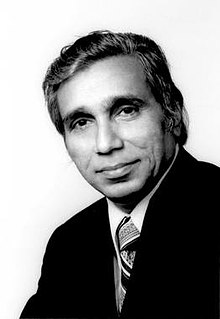
Back فضل الرحمن خان Arabic فضل الرحمن خان ARZ Fəzlürrəhman Xan Azerbaijani Фазлур Рахман Хан Byelorussian ফজলুর রহমান খান Bengali/Bangla Fazlur Khan German Φαζλούρ Ράχμαν Κχαν Greek Fazlur Rahman Khan Spanish Fazlur Khan Estonian فضلالرحمان خان Persian
Fazlur Rahman Khan | |
|---|---|
ফজলুর রহমান খান | |
 | |
| Born | 3 April 1929 |
| Died | 27 March 1982 (aged 52) |
| Resting place | Graceland Cemetery, Chicago |
| Nationality | British Indian (1929-1947) Bangladeshi (after 1971) American |
| Education | Bangladesh University of Engineering and Technology (BSc) University of Illinois Urbana-Champaign (MS, PhD) |
| Occupation | Engineer |
| Spouse | Liselotte Khan |
| Children | Yasmin Sabina Khan |
| Relatives | Abdul Jabbar Khan (sister's father-in-law) A.Z.M. Enayetullah Khan (brother-in-law)[2] |
| Engineering career | |
| Discipline | Architectural, civil, structural |
| Significant design | John Hancock Center, Willis Tower, Hajj Terminal, King Abdulaziz University, One Magnificent Mile, Onterie Center |
| Awards | Aga Khan Award for Architecture, Independence Day Award,[1] AIA Institute Honor for Distinguished Achievement |
Fazlur Rahman Khan (Bengali: ফজলুর রহমান খান, Fazlur Rôhman Khan; 3 April 1929 – 27 March 1982) was a Bangladeshi-American[3] structural engineer and architect, who initiated important structural systems for skyscrapers.[4][5][6] Considered the "father of tubular designs" for high-rises,[7] Khan was also a pioneer in computer-aided design (CAD). He was the designer of the Sears Tower, since renamed Willis Tower, the tallest building in the world from 1973 until 1998, and the 100-story John Hancock Center.
A partner in the firm Skidmore, Owings & Merrill in Chicago, Khan, more than any other individual, ushered in a renaissance in skyscraper construction during the second half of the 20th century.[8][9] He has been called the "Einstein of structural engineering" and the "Greatest Structural Engineer of the 20th Century" for his innovative use of structural systems that remain fundamental to modern skyscraper design and construction.[4][10] In his honor, the Council on Tall Buildings and Urban Habitat established the Fazlur Khan Lifetime Achievement Medal, as one of their CTBUH Skyscraper Awards.
Although best known for skyscrapers, Khan was also an active designer of other kinds of structures, including the Hajj airport terminal, the McMath–Pierce solar telescope and several stadium structures.[11][12]
- ^ "List of Independence Awardees". Cabinet Division, Government of Bangladesh (in Bengali). Archived from the original on 17 April 2016. Retrieved 29 November 2012.
- ^ Cite error: The named reference
jibwas invoked but never defined (see the help page). - ^ "Fazlur R. Khan (Bengali engineer) - Encyclopædia Britannica". Britannica.com. Retrieved 22 December 2013.
- ^ a b Mir, Ali (2001). Art of the Skyscraper: the Genius of Fazlur Khan. Rizzoli International Publications. ISBN 0-8478-2370-9.
- ^ File:Skyscraper structure.png
- ^ "Lehigh University: Fazlur Rahman Khan Distinguished Lecture Series". Lehigh.edu. Retrieved 22 December 2013.
- ^ Weingardt 2005, p. 75.
- ^ Weingardt 2005, pp. 78–.
- ^ Designing 'cities in the sky'. Lehigh University, Engineering & Applied Science. Retrieved on 26 June 2012.
- ^ Weingardt, Richard (February 2011). "Fazlur Rahman Khan: The Einstein of Structural Engineering". Structure. National Council of Structural Engineers Associations: 44.
- ^ Lynn S.Beadle pays tribute to Khan. National Academy of Engineering. 27 March 1982. ISBN 9780309034821. Retrieved 18 June 2014.
- ^ "Lehigh University: Fazlur Rahman Khan Distinguished Lecture Series". Lehigh.edu. Retrieved 18 June 2014.
© MMXXIII Rich X Search. We shall prevail. All rights reserved. Rich X Search